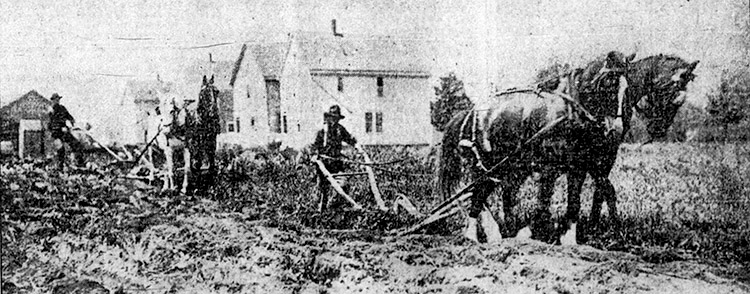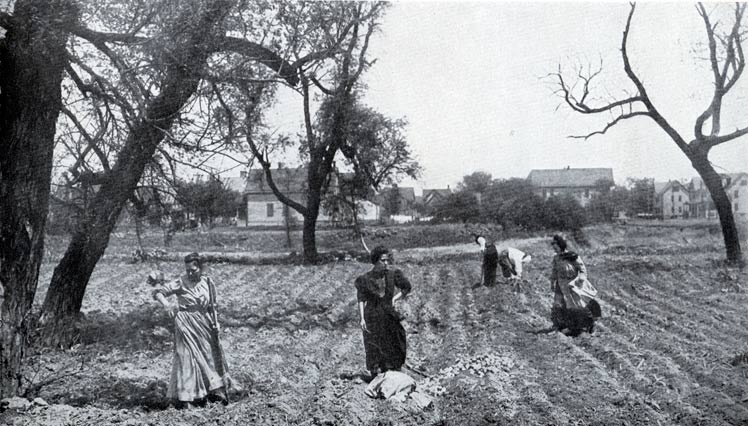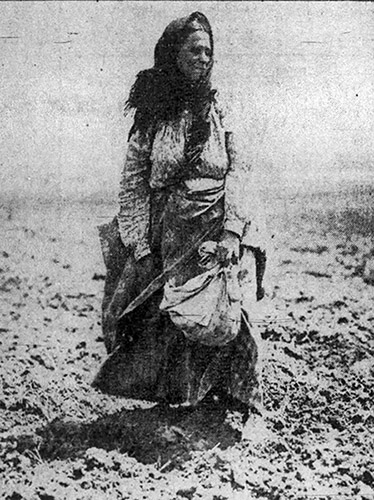The United States experienced one of its worst financial depressions during the 1890s, brought on by numerous factors including bank failures, overbuilding, and underconsumption of goods. The result was unemployment above ten percent for most of the decade. In a city like Buffalo, where large numbers of immigrants had only recently settled, the unemployed grew to 10,000 in 1893. The city, which had a Poor Department and poormaster, was overwhelmed by the need for assistance. The private charitable organizations under the umbrella of the Charity Organization were unprepared because so much of their philosophy and effort was directed at determining who among the poor were deserving and who were unwilling to work to help themselves. By 1895, private fundraising efforts were largely exhausted because the crisis continued and no jobs were available. Many destitute Polish and Italian immigrants pleaded with the poormaster for the price of tickets to return to their home country.
In 1895, Mayor Edgar Boardman Jewett, newly elected mayor of Buffalo, proposed that Buffalo follow the example Detroit which had utilized vacant land in the city for use by poor people as farms. The city would solicit the loan of such land from landowners, prepare the fields by having them plowed, and provide the seeds.
The Buffalo Express, in an editorial entitled "Think Again" on March 16, 1895, gave a hint of how out-of-touch many were about the scope of the problem:
"We wonder if it will be a valuable contribution to the Buffalo boom to tell the world that the conditions of laboring men in Buffalo is so desperate that the only way they can make provision for next winter is by working during the summer in a municipal potato patch!
"By the way, what reason is there for believing that the coming summer is not to be one of great prosperity in Buffalo and that, therefore, there will be fewer demands on the Poor Fund next winter than for the two previous winters?
"At any rate, would it not be cheaper, considering the effect on the outer world, for Buffalo to relieve its poor from the public treasury, as usual, and say nothing about it?"

Land for garden plots being plowed
1895 was the first year for the program of municipal gardens. W. A. Stevens, secretary of the Industrial Assocation, had charge of it and managed to persuade the owners of 250 vacant acres of city land to allow gardening. He also raised about $2,500 to purchase seed and equipment for the gardeners. A total of 578 plots were assigned to persons registered with the city; many more of the city's poor could have been accomodated had there been more vacant land made available. Each person who was awarded a garden plot had his/her public assistance cancelled; the city estimated that around 3,000 persons were removed from the rolls because the gardener had family members. (They would have received $2 a week from the city poormaster.)

Sowing the seeds
The program was not without its critics, but the resultis of the first year did much to silence them. Potatoes, cabbage, beans, squash, turnips, cucumbers, radishes,and beets were some of the varied produce that resulted. It was a great success with those who cultivated the gardens. Widows, women with children, and men who were no longer physically able to hold a regular job were the primary gardeners. One woman grew enough food to sell her surplus and still have enough for her winter. The supervisors of the garden plots evaluated the gardeners' attention to them; a small fraction of those who did not or could not tend their gardens were evicted and others from waiting lists were assigned.
The annual gardens continued for the next five years, through 1899. The roster of farmland made available to the city varied from year to year. In 1899, there were six farms offered by owners: the Tuscarora Land Company; Bailey Avenue & city line; Black Rock near Military Road; the island belonging to the city near the Snow Steam Pump Company; Seneca Street near the Lehigh Valley Railroad; the Twitchell farm on Abbott Road near the city line. The total acres utilized was 330.
And then in 1908, the program was restarted with a $3,000 investment in seeds, tools, and plowing. This time the city furnished each gardener with half of the seeds, leaving him/her to purchase more seeds on a sliding scale; some paid $.29 and others $2.00. The bulk of the plots were in South Buffalo.The Buffalo Express reported:

Cultivating the garden.
"To see the people at their work is a picture. The women, with their bright bandanas loosely knotted over their heads, hum foreign songs as they pull stubbornly at fractious weeds, smiling at the passing visitor or chatting across the boundary lines with their neighbors. Although good nature exisits in the main, yet the superintendents are called upon more often than is comfortable to decide which plot can boast of the superior product.
"The first plot visited yesterday was kept by an old woman who is a sufferer from asthma. She is 75 years old and handicapped by her malady, yet her rows of beans, potatoes, cabbage, pumpkins and other vegetables make a brave showing. The oldest person having charge of a plot is 81 years. The superintendents say that the older people, as a rule take the most active interest in the work and are both conscientious and honest."
The program continued into the next decade. In 1911, the city planned for 300 plots of around a quarter acre. The Buffalo mayor's office featured a display of some of the produce from the gardens that year. In 1913, the gardens were opened to the public so they could view the success of the program.
 The year 1914, during which the war in Europe began, was the Buffalo gardens' most successful year to date, according to the Buffalo Times; 386 plots were allotted. Superintendent John P. Young, ever mindful that the annual allocation of operating funds was never assured, extolled the gardeners. "I am sure it would be a revelation to many Buffalonians if they could see the work done in these gardens and observed the diligence of the small army of poor people to whom a good harvest means so much. I should be glad to have any citizen of Buffalo visit these farms and inspect the splendid work that is being done for the city's poor. In this work the city has not only been saved considerable money, but it has been counted one of the foremost cities of the country for modern philanthrophy."
The year 1914, during which the war in Europe began, was the Buffalo gardens' most successful year to date, according to the Buffalo Times; 386 plots were allotted. Superintendent John P. Young, ever mindful that the annual allocation of operating funds was never assured, extolled the gardeners. "I am sure it would be a revelation to many Buffalonians if they could see the work done in these gardens and observed the diligence of the small army of poor people to whom a good harvest means so much. I should be glad to have any citizen of Buffalo visit these farms and inspect the splendid work that is being done for the city's poor. In this work the city has not only been saved considerable money, but it has been counted one of the foremost cities of the country for modern philanthrophy."
In 1915, lots were obtained specifically for the unemployed factory workers in Depew and Lancaster. That year Lackawanna's mayor determined to set up garden plots for that city's unemployed. Buffalo was able to secure land enough for 500 plots. The next year, the city Poor Department said it was beseiged with applications for garden plots. Superintendent Kenngott of the Poor Department said he had no problem in securing sites for gardens. He said that about fifty percent of the gardeners were widows and many were foreigners.

Harvesting potatoes
He continued: "There are four main objects to be considered in the municipal gardening scheme. We aim to encourage thrift, to train children in the cultivation of soil, to make the waste places in our city both productive and beautiful and not to give charity, but to open an opportunity for people to help themselves by their own work."
In 1917, the year the U.S. joined the war in Europe, the municipal garden project coincided with the national push to grow more food as a war effort. Superintendent Kenngott asked the city to raise the funds allotted for the gardens from $2,000 to $5,000. His aim was to increase the garden plots to 700. To emphasize his point, he said, "I reiterate that which I have repeatedly stated in my annual reports, that there is in my opinion no better method yet devised for giving practical, material aid to the poor than gardens of that character." That year, 718 plots were cultivated, with a harvest worth $13,616.22. Mr. Kenngott also recommended that the city purchase land specifically for municipal gardens,
And then circumstances began to change. Although 616 plots were cultivated in 1919, the Poor Department reported that the requests for "city relief" was just 1,135, the lowest since 1913. The last mention of the annual progam was in 1920.The postwar years in Buffalo brought more employment and also a building boom. Those vacant lands were about to be developed.
Other cities adopted what became known as the Pingree Plan, named after Detroit's mayor who first conceived of the idea. Before conditions improved at the end of the decade, New York City, Minneapolis, Toledo, Syracuse, Chicago and St. Louis all had urban farms for their unemployed poor. The concept did not resolve economic or social problems or alleviate prejudice against immigrants, but it provided Buffalo's poorest citizens with the ability to feed themselves.